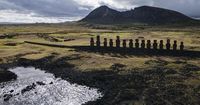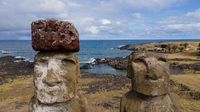Rising seas are threatening to wash away not just coastlines but also centuries of human history. According to a new study published in the Journal of Cultural Heritage, Easter Island’s world-famous moai statues—those enigmatic stone figures gazing over the Pacific—could face direct assault from powerful seasonal waves by as early as 2080, with the risk growing through the end of the century. The research, led by Noah Paoa, a doctoral student at the University of Hawaii at Manoa’s School of Ocean and Earth Science and Technology, paints a stark picture for both the island’s future and for global cultural heritage at large.
"Sea level rise is real," Paoa told the Associated Press. "It’s not a distant threat." And he should know: Paoa is not only a scientist but also a native of Easter Island—known to its Indigenous people as Rapa Nui. His connection to the land and its history adds a layer of urgency to the findings.
The study’s conclusions are the result of a sophisticated modeling effort. Paoa and his colleagues built a high-resolution "digital twin" of the island’s eastern coastline. They ran computer simulations to predict how various sea level rise scenarios would affect wave impacts in the coming decades. By overlaying these results with detailed maps of cultural sites, the team pinpointed which places could be inundated first. The results were sobering: the 15 moai statues at Ahu Tongariki, the largest ceremonial platform on the island, could be reached by waves as soon as 2080.
For those unfamiliar, Ahu Tongariki is more than just a tourist attraction. The platform, home to these towering moai, draws tens of thousands of visitors every year. It’s a cornerstone of the island’s tourism economy, but its significance runs deeper. The ahu is woven into the cultural and spiritual identity of the Rapa Nui people, standing as a testament to their ancestors’ ingenuity and artistry. The site lies within Rapa Nui National Park, which is recognized as a UNESCO World Heritage site—a status that underscores its global importance.
But Ahu Tongariki is not alone in facing this watery menace. The study found that about 50 other cultural sites on Easter Island are also at risk from flooding. That’s a staggering portion of the island’s archaeological heritage, and it’s not an isolated situation. A UNESCO report published in July 2025 confirmed that about 50 World Heritage sites worldwide are now highly exposed to coastal flooding. According to a UNESCO spokesperson, "In the Mediterranean and Africa, nearly three-quarters of coastal low-lying sites are now exposed to erosion and flooding due to accelerated sea level rise." The threat is global, and it’s growing.
The moai statues themselves are more than just stone sentinels. Carved by the Rapa Nui people between the 10th and 16th centuries, they were built to honor important ancestors and chiefs. The roughly 900 statues scattered across the island represent a remarkable feat of engineering, artistry, and social organization. But they are also vulnerable. Their location on coastal platforms leaves them exposed to the elements—and, increasingly, to the encroaching sea.
This isn’t the first time the island’s cultural treasures have faced disaster. In 1960, the largest earthquake ever recorded—a magnitude 9.5 event off the coast of Chile—sent a tsunami surging across the Pacific. It struck Rapa Nui and swept already-toppled moai even further inland, damaging some of their features. The monument at Ahu Tongariki was painstakingly restored in the 1990s, a testament to both the community’s resilience and the global recognition of the site’s value. But as Paoa and his team point out, the threat posed by climate change and rising seas is different. It’s gradual, relentless, and—if left unaddressed—potentially irreversible.
Faced with these daunting projections, what can be done? The study outlines several possible defenses for Ahu Tongariki and other threatened sites. These range from armoring the coastline and constructing breakwaters to the more drastic possibility of relocating the monuments further inland. Each option comes with its own set of challenges—financial, logistical, and ethical. Moving the moai, for example, would mean severing them from the very landscape that gives them meaning. On the other hand, doing nothing could mean losing them forever.
Paoa is clear about his hope for the study’s impact. "It’s best to look ahead and be proactive instead of reactive to the potential threats," he said. He urges that conversations about how to protect these sites must begin now, rather than after the damage has been done. This sentiment is echoed by many in the heritage conservation community, who argue that adaptation and mitigation strategies must be developed in partnership with local communities and with respect for cultural values.
The implications of the Rapa Nui study go far beyond the Pacific. As climate change accelerates, the world’s cultural heritage—its temples, statues, ancient cities, and sacred places—faces mounting risks. The UNESCO report highlights that the story of Easter Island is being repeated in dozens of places, from the ancient ruins of the Mediterranean to the coastal forts of Africa. Rising seas do not discriminate; they threaten the tangible links to our shared past.
For Easter Island, the stakes are especially high. The moai are not just relics; they are living symbols of a people’s history, pride, and resilience. The prospect of losing them—or seeing them battered by the waves—strikes at the heart of what it means to protect cultural heritage in a changing world. The study’s findings are a wake-up call, not just for Rapa Nui but for everyone who values the legacy of human achievement.
As the debate over how best to defend Ahu Tongariki and other vulnerable sites continues, one thing is certain: the clock is ticking. Whether through engineering, relocation, or some yet-undiscovered solution, action will be needed to ensure that the moai—and the stories they embody—endure for future generations. And as Paoa and his colleagues have shown, the time to act is now, before the rising tide becomes an unstoppable force.


